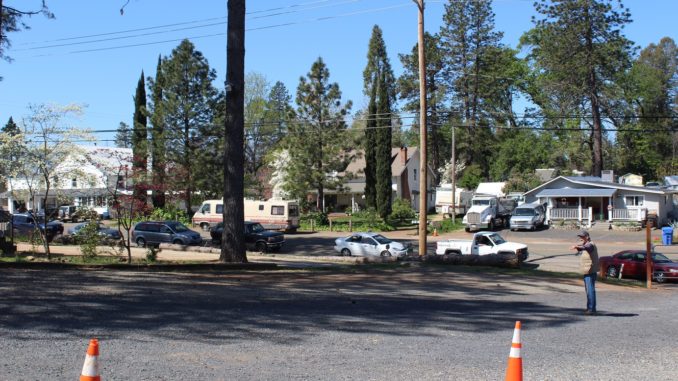
As cars lined the street outside the Magalia Community Church on a Tuesday morning last month, Pastor Kevin Lindstrom led a small group of volunteers in worship, praying that everyone arriving that day be “filled with peace and joy.”
Then the team that has dedicated itself to serving Camp Fire survivors sprang into action. As cars pulled into a makeshift drive-thru lane and people rolled down their windows to say hello, volunteers approached from a safe distance, giving them the rundown of available supplies.
Jennifer Cramer was one of the drivers that morning, three of her children in tow. As she loaded up provisions—including much-needed diapers—Cramer, a single mom, said the church has helped her put food on the table in the wake of not just one but two crises.
She called the facility’s services a life-saver. “It’s been really, really nice, because you can always count on them to help get you through,” she said.
The Magalia Community Church has found itself in a predicament amid the coronavirus pandemic, however, volunteer Doreen Fogle said. Since the state’s subsequent shelter-in-place order, the demand for food on the Ridge has nearly outpaced supplies.
What the church is experiencing is a microcosm of what’s occurring across the North State and beyond as inundated government agencies and helper groups alike grapple with the fallout from skyrocketing unemployment. Food pantries nationwide are seeing massive increases in the number of individuals seeking aid, but are faced with pandemic-triggered bottlenecks in the supply chain that have led to shortages. In fact, during a recent emergency distribution event in Chico, a local food pantry ran out of staples when an unprecedented 700 cars showed up that day.
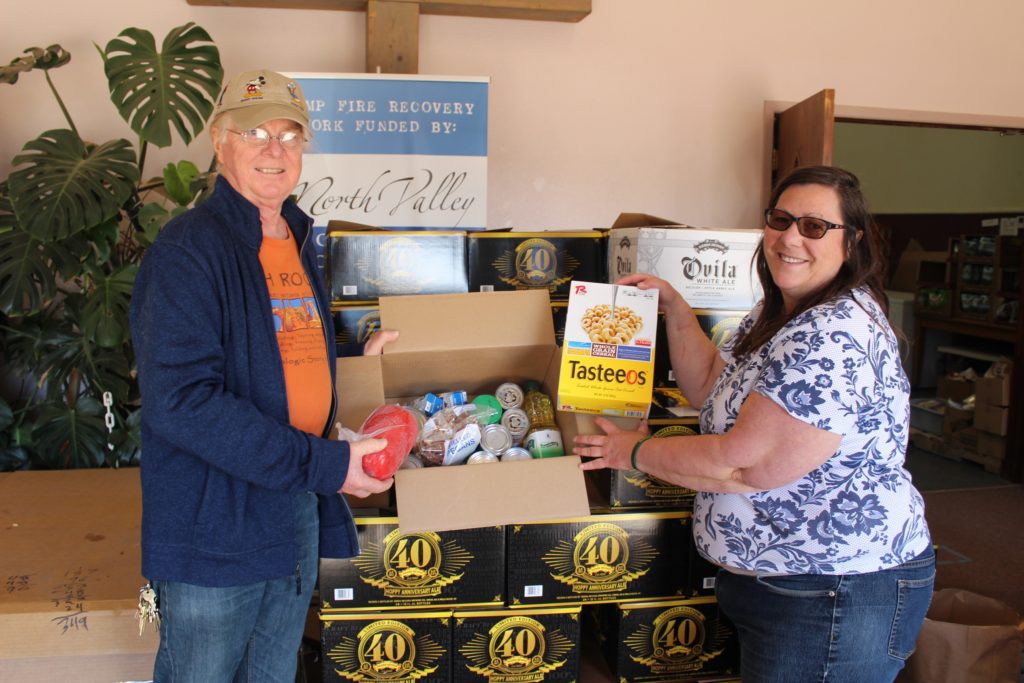
Fogle is worried. One of the Magalia Community Church’s major suppliers—a Bay Area-based food bank—started limiting deliveries to ensure that all of its partner organizations receive supplies during the pandemic.
Food has been the No. 1 need during the 18 months the Ridge church has served as a safety net in the region. If the volume of needy visitors remains consistent, Fogle said, the house of worship will have to reduce the amount of provisions it offers.
For those the tiny facility serves, residents hit hardest by the Camp Fire, the coronavirus is yet another destabilizing disaster.
“There are people that have told us they don’t know how they would have survived [without this food],” Fogle said. “It’s critical.”
Unprecedented need
The North State Food Bank—operated by the Community Action Agency of Butte County (CAA)—is among the COVID-19 resources listed on Butte-Glenn 211’s website. Last month, in response to the economic upheaval caused by the coronavirus, it received additional supplies from the state and set up emergency food distribution drive-thru sites. Those events will continue until at least June 1, every Monday and Friday (a schedule is posted online).
CAA Community Services Manager Tom Dearmore oversees the food bank. During a recent phone interview, he told the CN&R that the extra provisions are also routed through 52 sites—scattered throughout Butte, Colusa, Glenn, Plumas and Sierra counties—where the food bank regularly distributes supplies from the U.S. Department of Agriculture.
Dearmore noted that the local need has always been significant.
Indeed, the latest statistics available, cited in the 2019-2022 Butte County Community Health Assessment, illustrate the dire need long before both the pandemic and the Camp Fire. The USDA reported that in 2015, roughly 50 percent of Butte County lived in a food desert—a low-income area where a substantial number of residents have trouble accessing food. Additionally, roughly 1 in 6 people in Butte County experienced food insecurity in 2016, according to the national nonprofit Feeding America.
The last time the food bank received emergency food resources from the state was after the Camp Fire. Back then, its operators recorded as many as 350 cars at an event. This past month, they had to turn a few households away when distribution events in Chico and Oroville each drew twice as many vehicles, Dearmore said.
“If we could supply the need that’s there, we would need double what we have, easily,” he said. “Many of the folks lining up for food, it’s the same as after the Camp Fire—they aren’t typically in [a food] line. Everybody’s trying to make sense of this and feed their families.”
Dearmore noted that the food bank isn’t equipped to provide a family’s entire food supply. Its primary purpose is supplementing other resources or assistance programs, such as food stamps.
“It’s just not feasible that this small emergency [food] program could meet everyone’s need. But we sure wish we could,” Dearmore said. “Really, to be honest, we need people’s help. We need companies’ help. What we’re doing is just kind of brokering: We take donations, we take in food from the state, and we distribute it the best we can.”
Last Monday (May 18), the CAA held an emergency distribution event in Chico at the Church of Jesus Christ of Latter-day Saints on West East Avenue, where 100 cars arrived in the first hour. Butte County Sheriff’s Office personnel directed traffic, which wrapped around the parking lot.
After her trunk was loaded with provisions, one driver, who requested that she not be identified, told the CN&R she turned to the food bank to help feed her family after being laid off a couple months ago.
“It helps. We have canned food and stuff, but I’m so appreciative of the fresh fruits and veggies,” she said.

The rest of the afternoon was slower than expected, said Lee Wells, program supervisor for the food bank, but cars continued to steadily drive through to pick up nonperishables, meat and fresh produce. Even on slower days, the food bank still serves hundreds of families at these events, she added.
“No matter what, there’s still that need,” she said. “A lot of people I do talk to, they all say how grateful they are.”
Government response
Following the shelter-in-place mandate on March 19, the Butte County Department of Employment and Social Services (DESS) saw the number of applications for the Supplemental Nutrition Assistance Program (also known as CalFresh or food stamps) more than double.
From March 1 through March 15, the department received 561 applications. The rest of the month, another 1,292 were filed. In April, the department received 2,362 applications, a roughly 38 percent increase compared with the same month the prior year.
DESS Director Shelby Boston said the department has been inundated and that employees are working overtime to process the influx.
“[Staff] are working diligently [to ensure] that everyone who is in desperate need is getting what they need as quickly as possible,” she said.
The federal government has made some broad changes to the program in response to the pandemic that should speed up processing, Boston added, including waiving in-person interviews if individuals can verify their identity. Plus, households already on CalFresh that didn’t have the maximum allotment automatically received supplements to reach the limit.
“In some people’s situation it wasn’t a ton; it was maybe $14, but something was better than nothing,” Boston said.
The increased demand for food assistance is directly related to rising unemployment, Boston said.
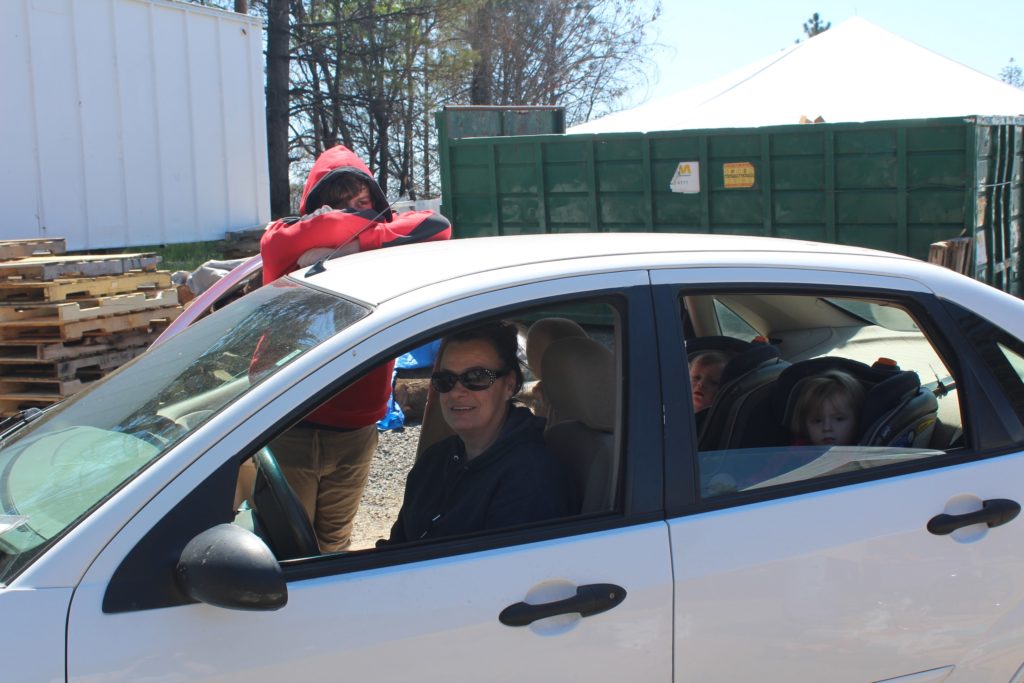
Early in the pandemic, local levels trended up to two points higher than than the federal level. Last month, Butte County’s unemployment rate skyrocketed to 14.9 percent from the 6.8 percent recorded in March, according to the California Employment Development Department’s Labor Market Information Division. Similar dramatic increases occurred statewide and nationwide, with the unemployment rate rising roughly 10 points, to 16.1 percent in California and 14.4 percent nationally.
Across the U.S., over 30 million people have filed for unemployment. The jobless rate is the highest it has been since the Great Depression.
Grassroots efforts imperiled
Butte County has long been home to local volunteer organizations stepping up to help provide much-needed food to families. The Chico Food Project, for example, typically collects upward of 70,000 pounds per year from local households through its signature blue bags. That program, however, is on hold due to safety concerns.
One recipient organization, the Chico Housing Action Team, had distributed 150 bags every 60 days to previously homeless individuals in its permanent housing program. CHAT is now attempting to source donations directly from the public.
The Chico Food Project formed in 2011 in the aftermath of the Great Recession.
“We were just trying to help people that were really struggling economically,” said co-founder Wendy Smith. “We wanted to keep people in their homes, to fill in the gaps for people so they wouldn’t have to become homeless.”
Smith said the demand for food assistance has trended upward over the years, noting the dramatic increase after the Camp Fire.
In the aftermath of the blaze, however, the nonprofit was able to intensify its efforts. This time is different. The pandemic has stymied volunteer work. Mid-March, the organization made the call to halt food collection until mid-June to protect the health of its volunteers, donors and participants. In addition, its primary distributor, the Chico Community Food Locker, had closed.
“We didn’t want to put people at risk, to have them going out to get food [to donate],” Smith said.
The closure of the Chico Community Food Locker—a program of the local Catholic Ladies Relief Society—was motivated by health and safety. All of the program’s volunteers are in the coronavirus-vulnerable age range of 65 years or older, volunteer coordinator Maureen Dion told the CN&R.
The organization has been distributing food to families in need for approximately 40 years. It serves over 8,000 people each year, including single adults, families and homeless individuals. Typically, its distribution center on Longfellow Avenue is open three hours a day, five days a week.
Since closing the facility the day after the shelter-in-place mandate, Dion has been making regular visits, posting fliers on the front door with updates about food services that are available elsewhere, just in case hungry people come by looking for help.
“We regret that we haven’t been able to be here,” she said. “A lot of us feel very bad that we can’t give out food, but we have to consider our volunteers.”
Some other groups, such as North Valley Mutual Aid and the Chico chapter of the Democratic Socialists of America, have stepped in to attempt to fill in the gaps during the pandemic, providing food assistance to homeless people sheltering in place at encampments and homebound seniors. In addition, the North Valley Community Foundation has awarded over 30 grants totaling roughly $289,000 to organizations providing food assistance via its Coronavirus (COVID-19) Rapid Response Fund.
David Little, NVCF executive vice president of programs and communications, told the CN&R that the charitable organization immediately began networking with its longtime partners to learn where to deploy donations during the pandemic. This is the same response NVCF had after the Camp Fire.
“Our goal was to fill in gaps, to find places where donations would make a difference in helping at-risk populations,” Little said by email. “Food and personal protective equipment quickly moved to the top of the list as the most pressing needs, but we’ve funded other things as well.”
Rationing measures
The Food Bank of Contra Costa and Solano has been a significant resource for Butte County, especially for Ridge residents. The Bay Area-based organization began hosting distribution events twice a month after the Camp Fire. It also delivers free provisions to smaller food distributors, pantries and churches that can also purchase additional food supplies at a discounted rate.
Lately, however, the organization has seen an unprecedented increase in demand. After the pandemic, the food bank made the call to temporarily limit how much supplemental food its partner agencies and food pantries can order “until the food supply normalizes,” said Lisa Sherrill, the organization’s communications director.
The reduction is significant for some providers.
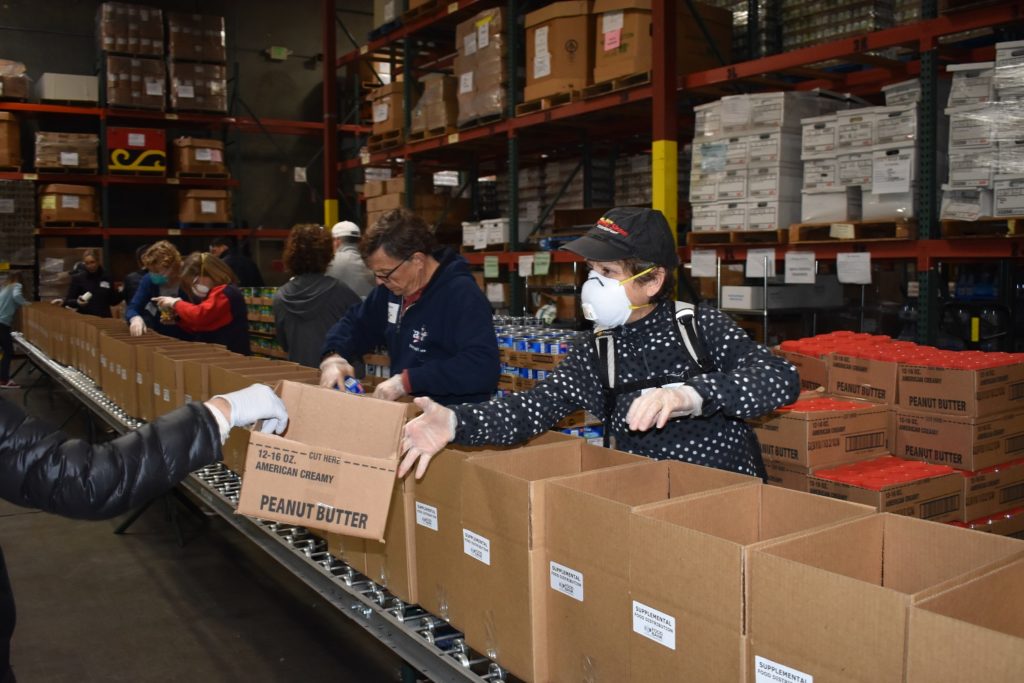
The Magalia Community Church, for example, had come to rely upon such orders from the East Bay food bank to meet the need on the Ridge. Prior to the pandemic, the church purchased as many as 10 to 15 cases. Now, it’s able to order only five cases per nonperishable product and two per dairy and meat product.
Sherrill explained that the food bank instituted the rationing measures for several reasons, including a spike in need and delivery delays. The organization is seeing a 30 percent to 50 percent increase in demand in its own backyard, she said.
Locally, a similar influx has occurred.
Lisa Roehling, the organization’s agency relations specialist for Northern California food banks, said demand during the pandemic has risen 50 percent at its Butte County distribution events, where approximately half of the attendees are Camp Fire survivors.
At the same time, the food bank is experiencing delays in deliveries from wholesalers, retailers and manufacturers in part due to people stockpiling, Sherrill said. In response, the organization has had to rely upon other, more expensive vendors. It purchased more food in mid-March through mid-May of this year than it did all of last year in order to keep up with the demand.
Limits on supplemental orders were put in place to ensure that all of the food bank’s partners are able to receive at least some additional food, Sherrill said.
It’s unclear how long the Bay Area food bank will operate this way, but Sherrill said she doesn’t expect the impacts of COVID-19 to let up any time soon.
“We’re definitely anticipating that increased need to continue for a while, especially as the unemployment rate is so high, and even if people are able to get back to work, they’re going to be playing catch-up for a while,” Sherrill said. “I think people who have been low-income already and were just on the edge now are going to have even harder of a time.”
Essential to survival
For the Magalia Community Church, responding to the unprecedented demand triggered by yet another crisis comes down not only to available supply but also to funding.
According to Fogle, the facility is getting by largely thanks to a $60,000 Camp Fire relief grant from the Latter-day Saints that provides food from its Bishops’ Storehouse locations. In addition, the Ridge church also recently received a second $10,000 donation from the NVCF for COVID-19 relief. But the money goes quickly: A month’s worth of food, for example, costs up to $15,000.
“That’s our biggest challenge right now, is just keeping food in stock,” she said.
The pandemic is a huge setback for recovery on the Ridge, where people are still living in RVs, cars and tents, Fogle continued.
“It’s a double whammy for the people up here, because some of them were just barely getting back on their feet, and some weren’t on their feet at all,” she said. “They were struggling to make ends meet … struggling to feed their families before this, and now it’s even worse.”
Lynnette March, who has relied upon the church’s free food and supplies since the Camp Fire, told the CN&R she “wouldn’t know what to do” without the facility.
After the blaze destroyed her home, March used the financial assistance she received from the Federal Emergency Management Agency to pay for a hotel room because “there was nowhere else to go.” Now, she and her 22-year-old son are living in an RV.
March said she was “an emotional basket case” from the compounding trauma due to the fire and her mother’s death shortly after the blaze.
For a long time, she didn’t feel that she could return to work. Now, she’s reached a place in which she feels ready, but jobs are even harder to come by than they were post-fire.
For March, the food and other necessities, like batteries, that the church provides to Camp Fire survivors are essential. Equally important is the kindness, care and dedication that its volunteers have shown to their community.
“If it wasn’t for this, I don’t know where I’d be right now,” she said. “This is absolutely key to our survival.”

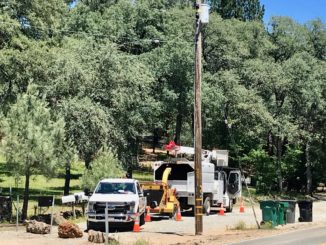
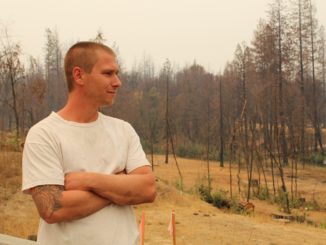
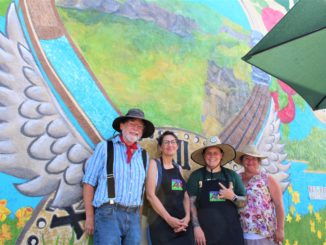
Chico Food Locker will re-open on Monday, June 1. Our hours are 9 – 12, M – F.